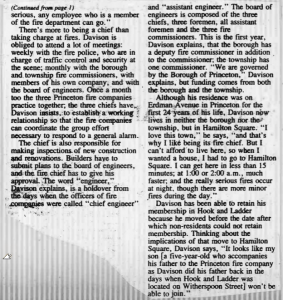Princeton Weekly Bulletin
Davison heads local firefighters
University plumber carries on a family tradition of town and gown service
By Jacquelyn Kaeen
For three generations Davisons have put out Princeton fires and worked for the University.
Terrence, a plumber in the Maintenance Department, became Princeton’s fire chief on New Years Day. He is a member of Hook and Ladder, located on Harrison Street. It is one of three companies that serve the borough and township. Davison’s father, Samuel G., was its chief in 1963; he volunteered there for 49 years. His grandfather, Samuel S. and three uncles were all members of Princeton Engine Company Number One on Chestnut Street.
Terry has worked at the University for 10 years; his father, for 50 years as an electrician; and grandfather, also an electrician, for 50 years. Among them the Davisons have logged 110 years of service to the University.
All their work as firemen on behalf of the community has been as volunteers. Davison, who figures he puts in an average of 20 hours a week as chief, gives his time because “I’m into it. A lot of people don’t realize the effort it takes to keep a fire department running. We practice twice weekly,” he says, on the “who does what when” of crises ranging from small fires to general alarms and chemical spills.
Davison says his company “makes an average of 200 runs a year, mostly minor fires. When you hear the honkers and siren, that’s when it’s serious. You don’t hear the alarm for most fires anymore.” he explains, because the volunteers carry beepers. Fire calls go to the police whose dispatcher alerts the volunteers.
What does the chief do? “At the scene,” Davison explains, “the chief has to make decisions on the method of attack; we have to locate hydrants, lay streams from hydrants to pumpers, position apparatus, lay the attack lines, make the ladder set-ups and organize the teams (ladder, ventilating, rescue). Everybody knows how to do everything,” he says, but for any given fire, each person has to be integrated into one of the teams and the activity of the teams coordinated. “That’s what the chief does,” Davison emphasizes, “decide and organize.”
Sometimes, he admits, his job at the University keeps him from responding. “There are crises in plumbing too.” When a conflict occurs, his two assistant chiefs take over. But the University is supportive. “There’s a policy,” he says, “if the alarm is …
(Continued from page I)
serious, any employee who is a member of the fire department can go.”
There’s more to being a chief than taking charge at fires. Davison is obliged to attend a lot of meetings: weekly with the fire police, who are in charge of traffic control and security at the scene; monthly with the borough and township fire commissioners, with members of his own company, and with the board of engineers. Once a month too the three Princeton fire companies practice together, the three chiefs have, Davison insists, to establish a working relationship so that the fire companies can coordinate the group effort necessary to respond to a general alarm.
The chief is also responsible for making inspections, of new construction and renovations. Builders have to submit plans to the board of engineers, and the fire chief has to give his approval. The word “engineer,” Davison explains, if a holdover from days when the officers of fire companies were called “chief engineer” and “assistant engineer.” The board of engineers is composed of the three chiefs, three foremen, all assistant foremen and the three fire commissioners. This is the first year, Davison explains, that the borough has a deputy fire commissioner in addition to the commissioner; the township has one commissioner. “We are governed by the Borough of Princeton,” Davison explains, but funding comes from both the borough and the township.
Although his residence was on Erdman Avenue in Princeton for the first 24 years of his life, Davison now lives in neither the borough nor the township, but in Hamilton Square. “I love this town,” he says, “and that’s why I like being its fire chief. But I can’t afford to live here, so when I wanted a house, I had to go to Hamilton Square. I can get here in less than 15 minutes; at 1:00 or 2:00 a.m., much faster, and the really serious fires occur at night, though there are more minor fires during the day.”
Davison has been able to retain his membership in Hook and Ladder because he moved before the date after which non-residents could not retain membership. Thinking about the implications of that move to Hamilton Square, Davison says, “It looks like my son [a five-year-old who accompanies his father to the Princeton fire company as Davison did his father back in the days when Hook and Ladder was located on Witherspoon Street] won’t be able to join.”

Photo Caption: Terrence Davison